Report

This article is Section 2.4 of Bain’s 2020 Global Private Equity Report.
It’s rare that a private equity deal model doesn’t devote at least a line or two to pricing. Firms are careful to protect themselves against potential changes in market conditions that might affect a target company’s ability to get its price. What would the incursion of Amazon or a low-cost Chinese competitor do to cash flows? How could industry overcapacity upset projections? Will competitive dynamics allow us to raise prices, and if so, how fast?
Far less common is a deal thesis that establishes pricing—and a company’s ability to execute on it—as one of its pillars. This shifts the focus from external considerations to things a management team can actually do something about. What happens to cash flows if the company significantly raises its game on pricing? How many basis points of margin can we capture if we apply our battle-tested pricing model to the next acquisition? Can we use tools and data to better spot opportunities? Can we eliminate leakage by training our sales team to execute more consistently?
At a time when record amounts of capital are chasing a limited number of high-quality assets, answers to questions like these can unlock value that isn’t already baked into deal multiples. They point to strategies PE investors can use to boost top-line growth, rather than focusing on tuck-in investments or leverage alone to move the valuation needle during ownership. It’s not news that every new dollar captured through pricing falls straight to the bottom line. But, as with so many aspects of operating a business today, data and technology are enabling companies to price more precisely and deploy strategies more surgically.
Creating value through better pricing, in other words, has gotten more accessible in recent years.
Still, few management teams have a firm handle on pricing, suggesting there’s ample room to add value. According to a Bain global survey of more than 1,700 B2B business leaders, 85% of management teams believe their pricing decisions need improvement, and only 15% have effective tools and dashboards to set and monitor prices. When it comes to encouraging pricing integrity, only 13% of companies said they have effective incentives at the front line. The upside from turning these percentages around is significant. Our experience shows that building new pricing capabilities and improving leadership around pricing can add 200 to 600 basis points to a company’s bottom line (see Figure 2.16).
Building new pricing capabilities can significantly improve a company’s profitability

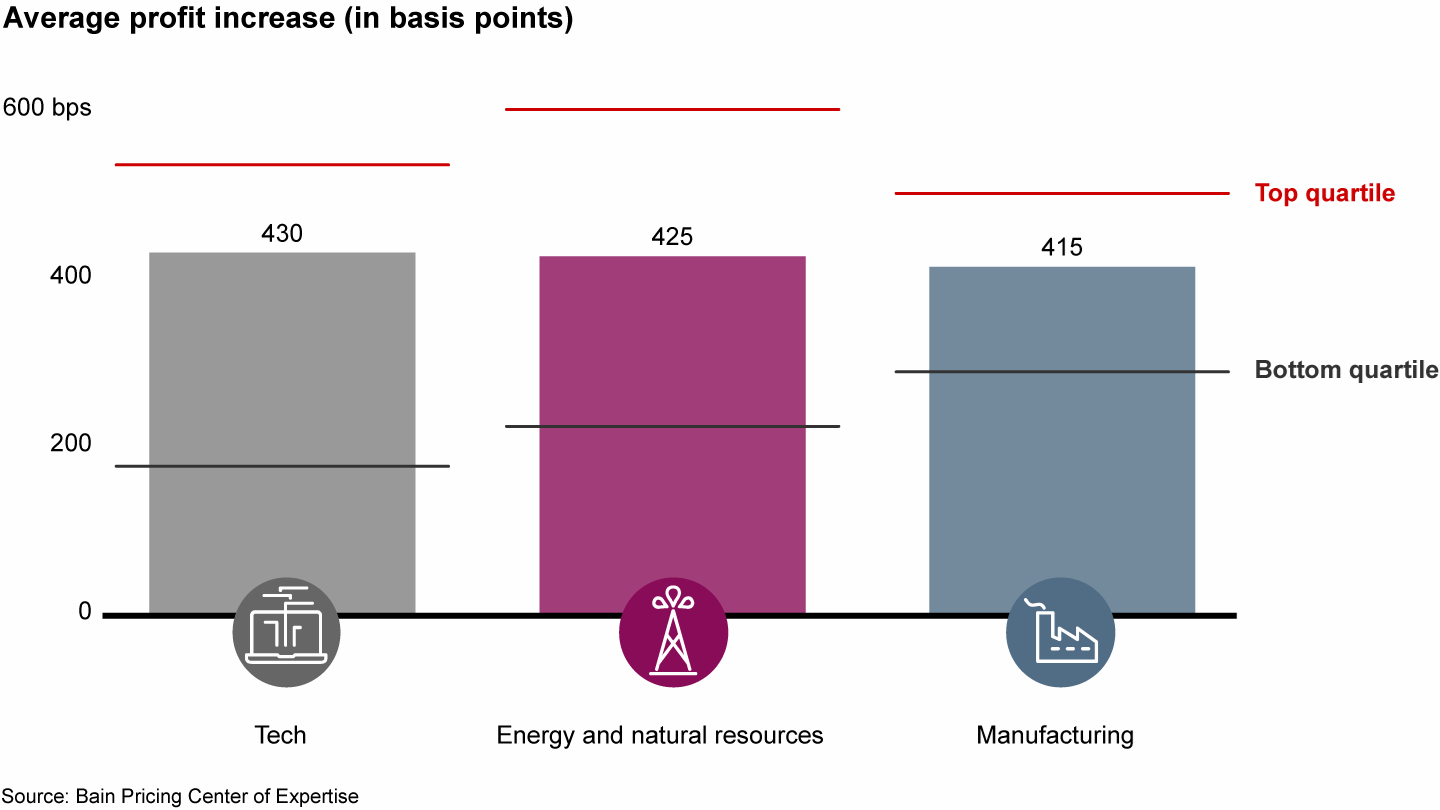
The firms creating that kind of value recognize that developing new pricing muscles is a multiyear journey, requiring attention at each phase of the deal cycle. They identify the most valuable opportunities in due diligence, verify them in the first 100 days of ownership, execute against a clear set of actions and, as they prepare to exit the asset, do a refresh to confirm the model across the company. The objective is not an opportunistic, one-time adjustment. It’s a shift in behaviors and pricing infrastructure that hardens the benefits into something sustainable.
Due diligence: Quantify opportunity and capability
Assessing the size of the prize in pricing is a two-part challenge. Advanced analytics will inevitably reveal opportunities to price more confidently and intelligently in a given segment or with specific customers (see Figure 2.17).
Identifying pricing upside in due diligence involves analyzing a broad set of market- and customer-specific indicators

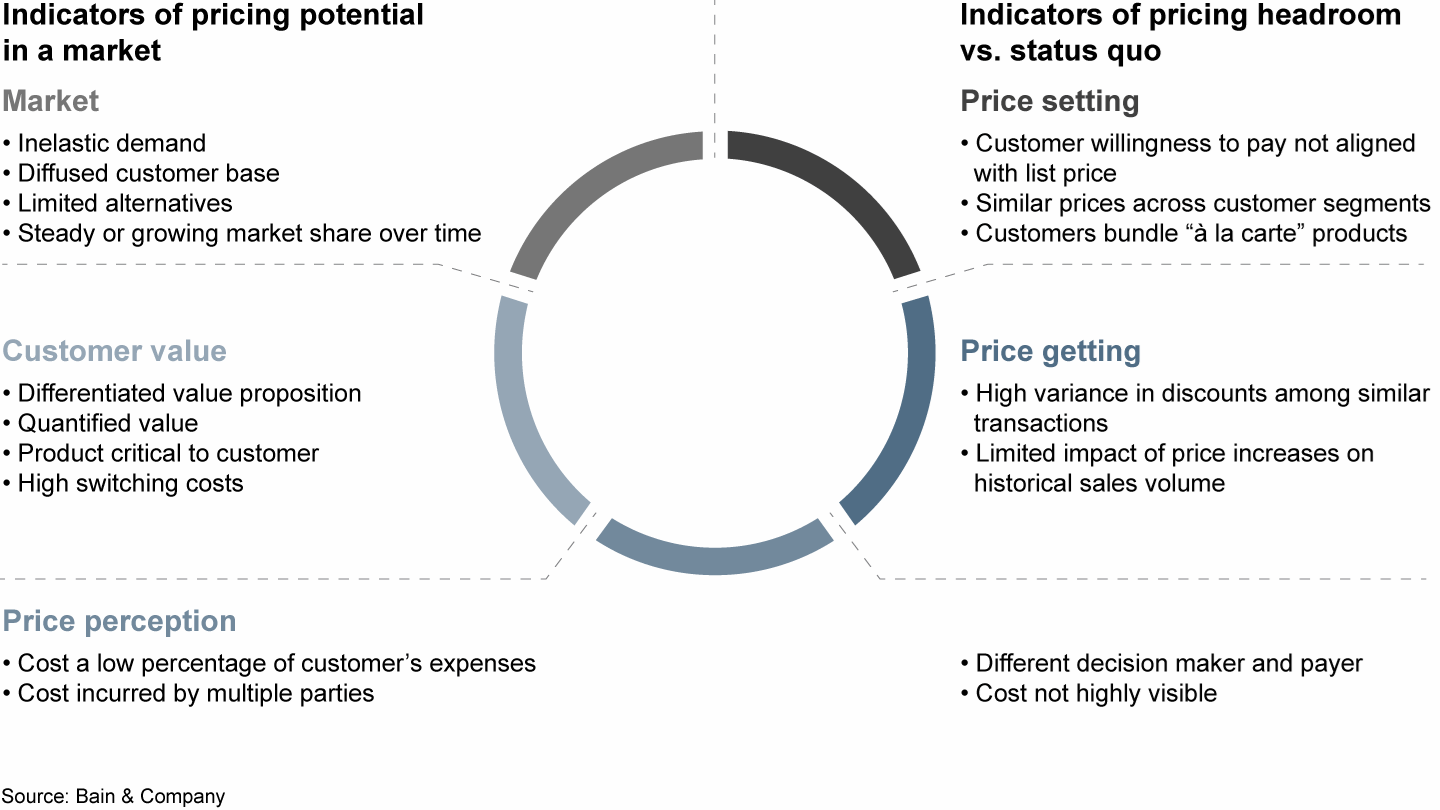
But data alone won’t tell you whether those opportunities are within reach. That requires an integrated approach to due diligence that puts pricing opportunities in their commercial and organizational context. Buyers need a pragmatic, on-the-street understanding of customers and competition to help gauge the likelihood that specific pricing actions will stick. They also need to assess whether the organization has the people, tools and capabilities to execute effectively, and whether the leadership team has the experience and ambition to use pricing as a competitive weapon.
This type of integrated analysis came into play when one global private equity firm targeted a provider of professional training services. The objective was to marry the vital outside-in perspective on pricing opportunities in the market with an integrated, inside-out view of the firm’s past performance on pricing and future potential.
Standard commercial diligence showed that the company had a strong value proposition and that customers viewed its products as essential, suggesting it would get limited pushback on price increases. Extensive interviews and statistical analysis determined that these professionals and their employers valued the target company’s training software because it delivered measurable benefits: Training led to higher retention levels and a $10,700 increase in annual salaries. The company’s competitors were focused on a different segment and didn’t pose much of a threat. But those companies had gotten more aggressive on pricing without scaring away many customers.
All of this signaled an opportunity to raise prices from 5% to 20% (depending on the product), which would translate into a 7% to 12% uplift in EBITDA within the first year of ownership. Realizing that result, however, would require investment. The inside-out capability analysis showed that the company lacked pricing discipline. The sales team engaged in wide discounting for some products and focused discounting for others. None of it was correlated to customer spending, and there was limited rationale for price movements over time. This was unsurprising, given that the company lacked a central team to do structured analytics and A/B testing on price promotions.
But these problems were fixable. After interviewing management and modeling the capabilities needed to win, the deal team found that strong hires for a few key positions would end up being accretive to earnings.
More often than not, robust due diligence will identify this sort of tiered opportunity based on where the company is on the pricing learning curve. The first-level consideration is whether the company can manage transaction pricing effectively and whether the sales team can get the right price consistently. Level two is determining what it will cost for the company to get better at determining product value and aligning it with the right price for the right customer. Finally, how can the company bring it all together, to use pricing as a competitive weapon by setting and refining prices dynamically, depending on market and customer circumstances? What’s the upside in wielding price to optimize the company’s customer mix and take the offensive against the competition?
Recent due diligence of a software company showed that the management team had already discovered the power of pricing discipline. Based on an analysis of historical transaction data, the deal team could see that the company had moved from a significant amount of price variation (salespeople charging whatever they wanted, essentially) to little variability. The transition had produced some customer churn, but not much, which signaled that the management team had succeeded in identifying the right value proposition and communicating it to customers.
From a buyer’s perspective, that meant management had captured the level-one opportunity. But it also meant the existing team was well positioned to move on to levels two and three during ownership—increasing list prices on differentiated products, creating more value through improved packaging, and deploying other, more sophisticated strategies.
The key benefit of an integrated approach to due diligence is that it is practical. By viewing the target holistically, it identifies how market opportunities match up with in-house capabilities. It shows a buyer what it would have to fix, what it would take to fix it and how much the fix might be worth in terms of ongoing EBITDA uplift.
Pricing diligence tends to be either too high level or stuck in the analytical weeds. Neither approach helps a buyer understand what a company is capable of or how pricing moves will be received by the market.
The first 100 days: Validate and get moving
The first days of an investment provide a unique opportunity to make change. This is especially true when it comes to pricing. Equipped with real transaction data and unfettered access to decision makers, deal teams can validate what they thought they saw in diligence and mold those findings into a clear, actionable value-creation plan. Moving quickly is critical.
Lack of pricing discipline often results from inertia, poor leadership and affection for the status quo, especially in the B2B space, where everything is negotiated and customer relationships are hard-baked. The change in ownership creates a golden opportunity to shake things up. The process of harvesting quick wins allows the buyer to assess talent and capabilities, verifying words with deeds. Early opportunities most often show up in three areas: understanding customers’ willingness to pay, testing if discounts are rational and probing for price leakage, when value is given away through unintended discounts such as relaxed payment terms or expedited shipping.
Many companies leave money on the table because they don’t appreciate what a given customer is willing to pay or how to optimize price across the customer and product mix. These blind spots make salespeople timid about demanding price increases over the life of a contract. To define the scope of this problem right away, firms can analyze whether existing discounts are rational by correlating deal size to discounts made (see Figure 2.18). This will identify outliers where discounts have been granted due to the negotiating acumen of the customer.
Correlating discounts and deal size can help determine if a company’s discounting behavior is rational

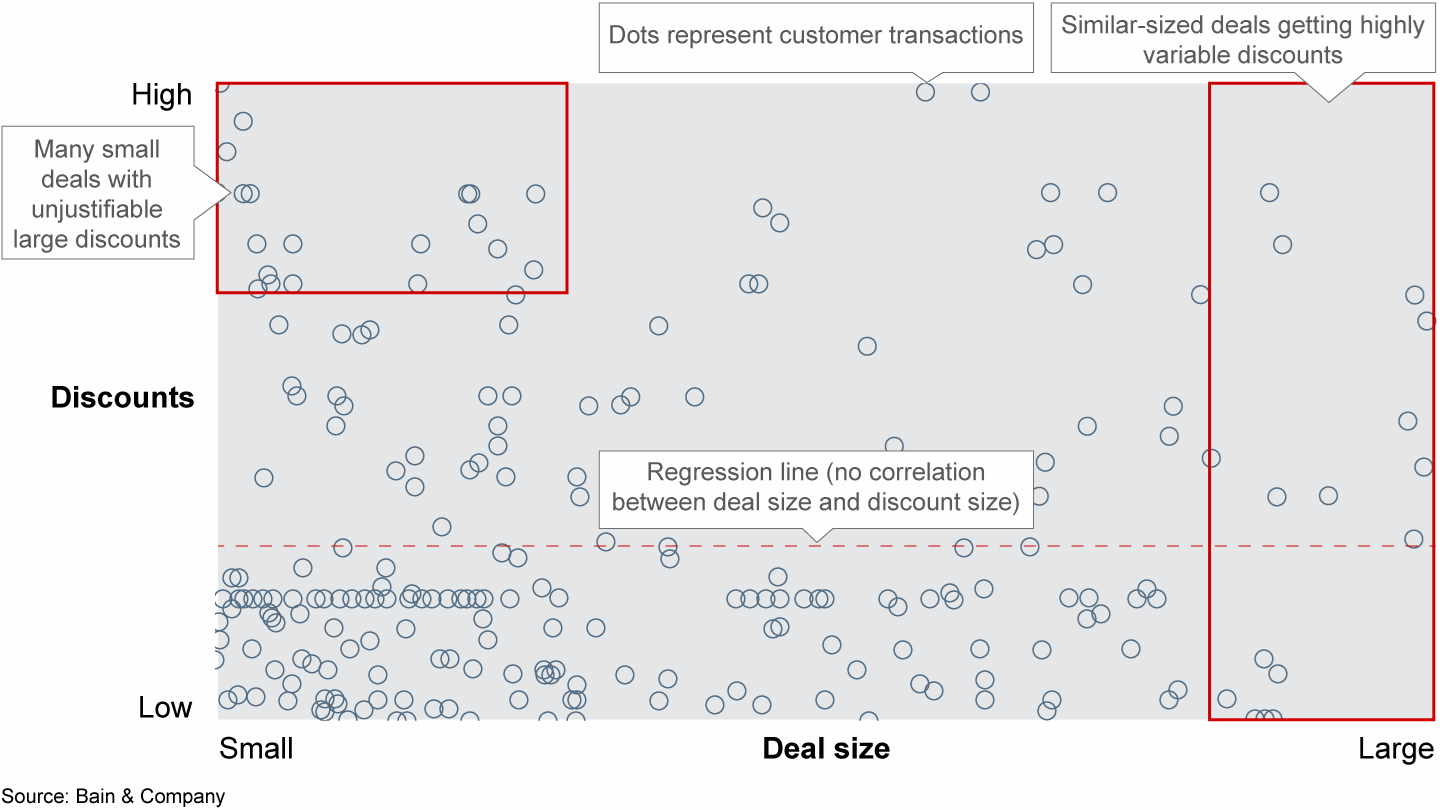
It will also test the organization’s chops in terms of capabilities and leadership, suggesting where investment in people, data and process will make the most difference. Real data is critical to create alignment and give sales leaders ammunition to guide their (often reluctant) teams. Working together to define the sales rep “strike zone” helps win the kind of buy-in that ensures consistency in price quoting and discounting.
Turning price leakage into leverage can produce powerful early wins. At most companies, selling decisions and contract terms stack up over time, creating hidden discounts for customers. New contracts grandfather in old rebates, special product features, free trials and other benefits, often without assessing their impact on margins. The discounts themselves aren’t necessarily bad; the lack of clarity is the problem. Without knowing if the price being charged captures all the underlying costs, it’s impossible to understand how profitable (or unprofitable) the relationship really is.
When London-based Intermediate Capital Group acquired Loparex in 2015, getting a handle on the breadth and diversity of products was a major challenge. The company had operations in the US, Europe and Asia. It made specialty paper and film release liners for a wide variety of end markets, ranging from nonstick material for Band-Aids to peel-off films used to prevent scratching on airplane fuselage parts. The investment had stalled until 2017, when ICG brought in a new CEO, Simon Medley, who had a strong background in making pricing and commercial excellence strategies work.
When Medley dug in, he saw that Loparex had little data on profitability by end market, customer or product type. It didn’t know whether the cost to serve a given market aligned with what customers really valued. The company relied on a basic cost-plus analysis, focusing on material and manufacturing costs. But it didn’t price for the underlying costs associated with producing highly bespoke products—things like two-sided printing and variations in product width that led to extra tooling changeovers or incremental R&D expenses.
Loparex was essentially in the dark strategically: It was both undercharging customers where it had the opportunity to increase prices and missing opportunities to increase volume by lowering prices.
To solve the problem quickly, Medley deployed an analytical tool called a profit cube (see Figure 2.19). Combining financial data, plant data and customer data, the cube redistributed costs by product, customer and sector, drawing a precise picture of how items like bloated accounts receivable balances and hidden freight costs affected profitability.
A profit cube analysis breaks down product and customer costs, pinpointing sources of margin leakage

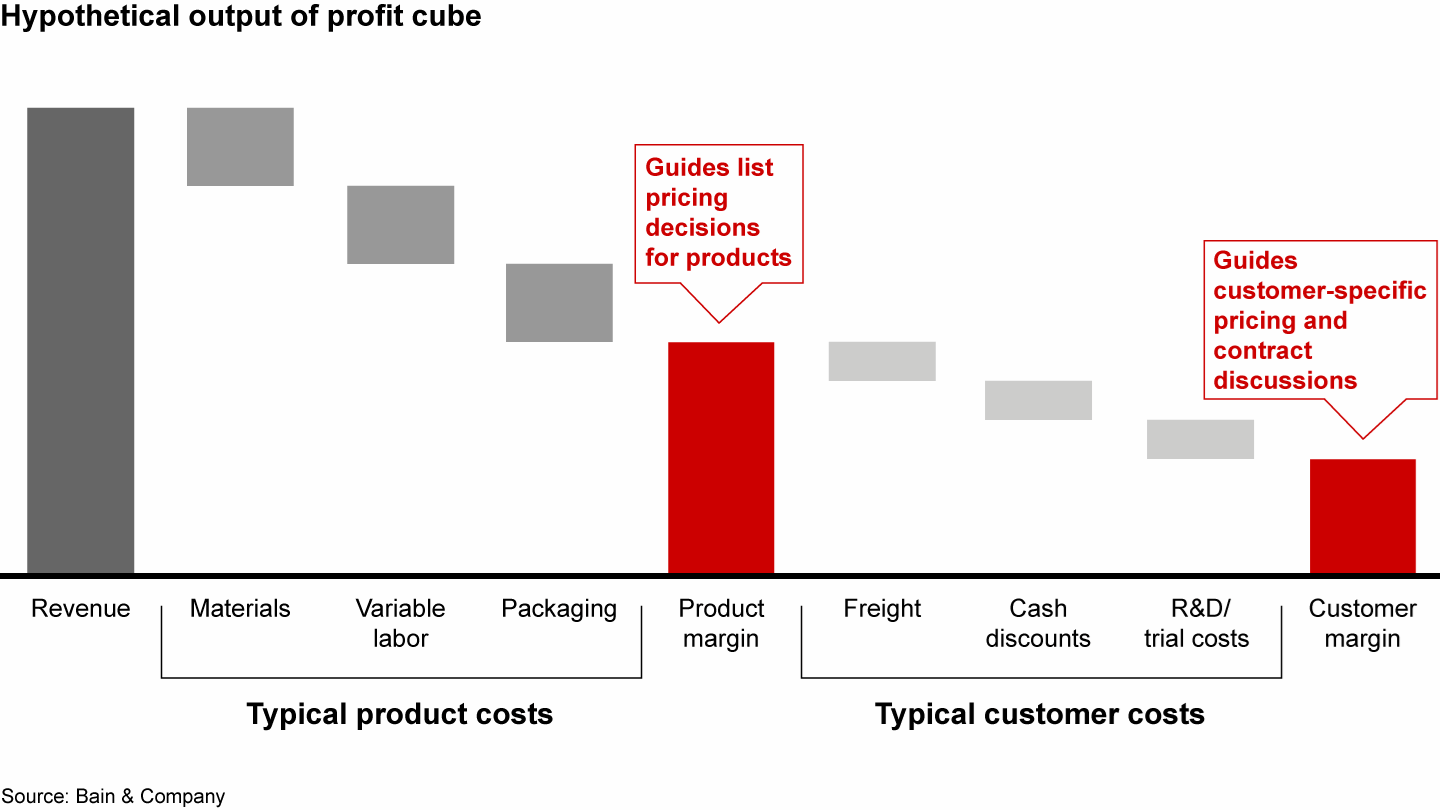
The profit cube became the company’s source of truth on cost, allowing top leadership and sales to come together over critical pricing decisions—namely, how to either adjust pricing to reflect real cost or work on cost to make pricing more competitive. The company discovered that a majority of earnings came from a quarter of its products and less than half of its customers. That allowed the entire organization, from sales to R&D, to direct resources toward the areas where they could drive the most profit.
In the first 100 days of a new investment, the goal is to bring analytical rigor to the deal hypothesis, capture quick wins where available and create alignment on what the company needs to do to make a step change in performance over the medium and longer term. After Medley took over at Loparex, he knew that reliable analytics could produce critical buy-in. That meant involving stakeholders throughout the organization in the profit cube’s construction and then cocreating a set of solutions, market by market and customer by customer.
Ownership: Build lasting value
Success in executing on the value-creation blueprint depends on strong leadership. There’s nothing easy about renegotiating contracts and pushing through price increases. But it will also hang on the strength of the plan itself—all the analytical rigor on pricing has to lead in a practical direction. The mark of a high-quality plan is that it lays out what the company needs to do in terms of building capabilities, adding talent, or tapping expertise and tools to ensure strong performance (see Figure 2.20). Just as important, it provides the sales organization with the guidance, incentives and support it needs to do the hard work of making pricing initiatives stick.
To capture lasting value from pricing, define a clear roadmap and practical steps for executing on it

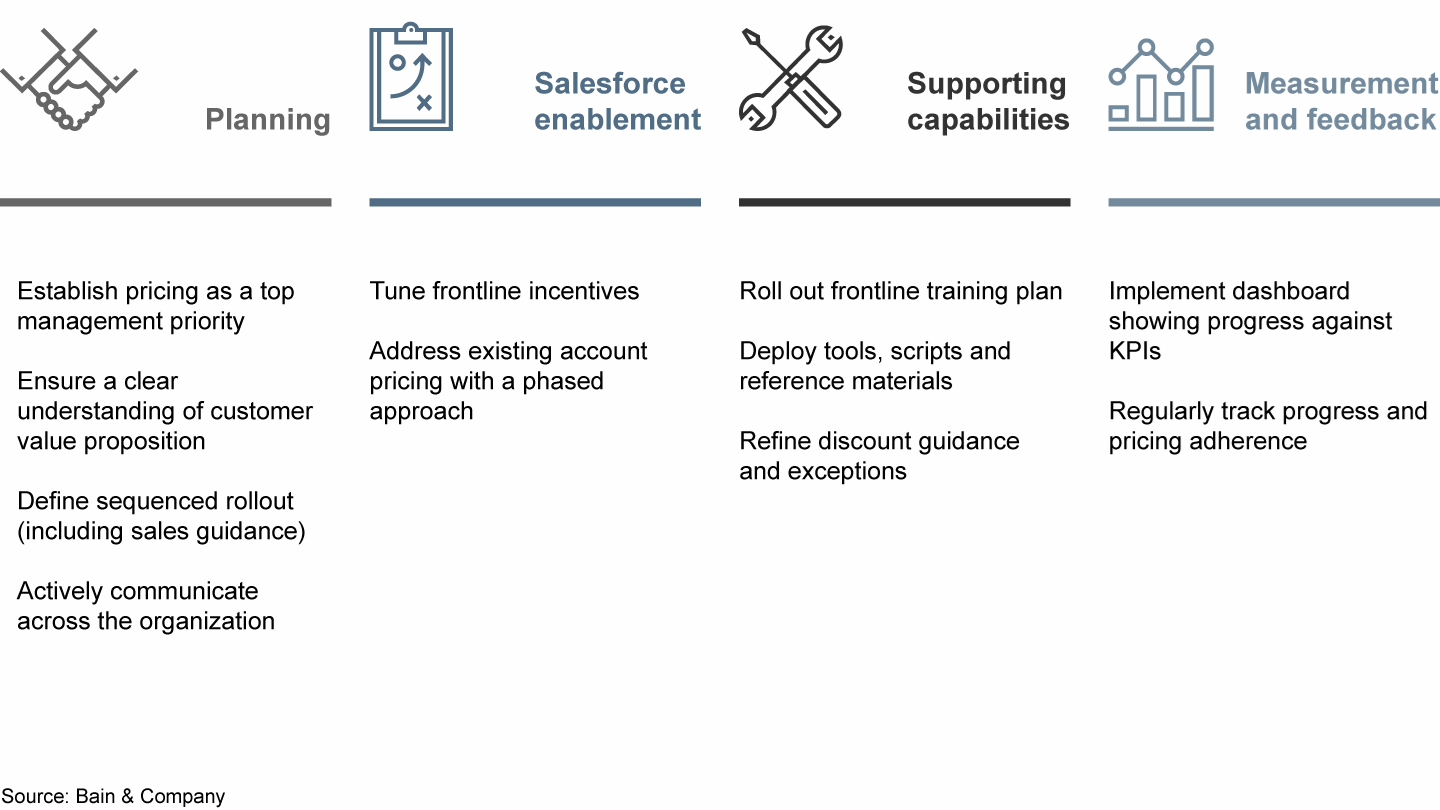
For Loparex, that meant institutionalizing the profit cube intelligence. The company hired two full-time analysts to manage the profit cube and monitor performance against it. The executive team also set up a monthly meeting to look at pricing data and act on it.
Profitability became the new vocabulary of the business. Leadership held salespeople accountable for selling decisions like nonstandard printing concessions that led to price leakage. But it also gave reps an Alteryx-based tool that could pull cost data by customer and product from the web, allowing them to build more strategic account plans. With real insight into costs, salespeople could engage customers in discussions about how to deliver the right products at the right price to produce mutual value. Reps found that customers were often more willing to make trade-offs than they had once thought. Installing the profit cube and the other moves to support strategic pricing helped boost EBITDA by 25%.
This wasn’t a one-time “pricing project.” The strategy worked because it targeted the development of pricing capabilities, resulting in a model that could be sustained and repeated.
The most successful firms look at the pricing challenge that way from the beginning and apply a range of change management disciplines to embed it in the organization. They launch a pilot with a passionate leader, prototype and test success, publicize and reward wins, and then build a repeatable model and roll it out across the organization. The goal isn’t a short-term bump in EBITDA but a change in the way the company works. This helps ensure that the pricing gains are reflected in the purchase multiple paid by the next buyer.
Pre-exit: Consolidate success
Private equity investors often think about pricing and growth initiatives as a trade-off: “I can either spend my time chasing price, or I can focus on growth.” A sustainable and repeatable pricing model, however, will actually complement growth strategies and even accelerate them. This isn’t to suggest that most deal teams have the bandwidth to do everything at once. But by starting early, the firms that get pricing right have a chance to apply pricing discipline in the context of everything else they do to build growth and create value.
Growth plays are inevitably disruptive. Acquiring new businesses, expanding a salesforce, launching new products or moving into adjacencies—all of these strategies have implications for pricing. So a portfolio company that develops muscles around pricing strategy and execution in the first couple of years of PE ownership can use this capability to monetize the growth play much more successfully.
An acquisition, for instance, might add 200 new salespeople who need to be integrated into the acquirer’s ways of working. It may build scale or scope that changes the combined company’s value proposition. Having a proven model in place to diagnose pricing opportunities and execute strategy gives leadership a means to make high-impact pricing decisions quickly. It can shorten the time to value as teams seek to integrate the new organization and develop a consolidated growth plan.
The pre-exit period is the time to revisit the due diligence and tee up the pricing opportunities that remain for the next owner. For all the right reasons, teams rushing to take advantage of growth opportunities may have to divert their attention from pricing for a while. As they ready the asset for sale, however, shoring up earlier pricing strategies and applying the model to the new, larger enterprise can surface quick wins and pricing opportunities that burnish the equity story for a new buyer.
For the current owner, the new pricing capability helps ensure there’s no money left on the table. For the new owner, a demonstrated ability to use price strategically provides a credible runway for future value creation.
Capturing pricing upside is a powerful and underappreciated path to value, especially when heavy competition is driving up deal multiples. Most target companies are behind the curve in pricing analytics and strategy, which means that private equity investors can build a strong, differentiated bidding advantage by identifying and underwriting pricing opportunities in due diligence. Creating lasting value involves building new capabilities and ways of working, stretching from the leadership team to the go-to-market organization. But the payoff is evident: a more profitable portfolio company with the tools in place to create future growth.
Explore the report
More from our 2020 Private Equity Report
Private Equity Report
This article is part of our 2020 Global Private Equity Report.